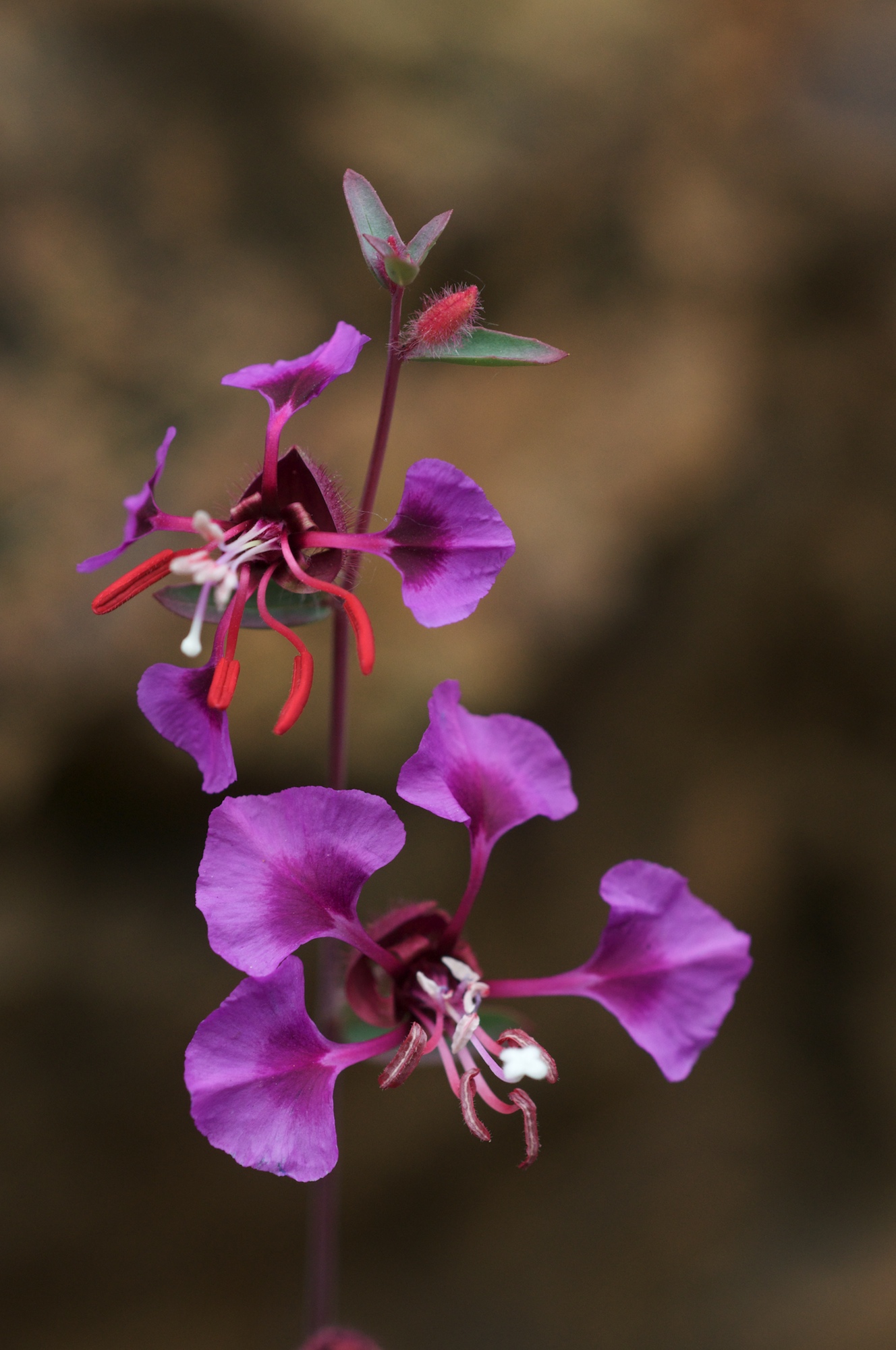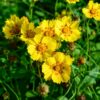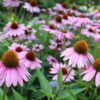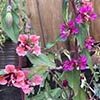Key Takeaways
Clarkia, also known as Farewell-to-Spring, is non-toxic to dogs, making it a great addition to pet-safe gardens.
Identifying Clarkia is easy with its distinctive pink to lavender flowers, and it thrives in California’s native landscapes.
For optimal growth, Clarkia prefers well-drained soil and full sun to partial shade exposure.
Regular watering, especially during dry spells, and minimal fertilization are key to Clarkia’s care.
Incorporating Clarkia into a garden alongside other dog-friendly plants creates a safe and engaging environment for pets.
“Clarkia unguiculata – Wikipedia” from en.wikipedia.org and used with no modifications.
Clarkia: A Safe Bloom for Your Furry Companion
When it comes to gardening, one of the joys is being able to share the beauty and bounty with every member of the family, including our four-legged friends. As a pet owner, ensuring that each plant you introduce into your garden is safe for your furry companion is paramount. Fortunately, Clarkia, a charming native of California, is just such a plant. It’s not only safe for dogs, but it also adds a splash of color and texture to your landscape.
Identifying Clarkia Species
Clarkia, with its showy blooms, is a favorite among gardeners and butterflies alike. Recognizing Clarkia is quite straightforward – look for its cup-shaped flowers that range in color from vibrant pink to a gentle lavender. The blooms often have a distinctive dark spot at the base of each petal, making them a standout in any garden setting.
General Safety of Clarkia for Dogs
Now, let’s address your primary concern head-on: is Clarkia toxic to dogs? You can breathe a sigh of relief because the answer is a resounding no. Clarkia, also known as Farewell-to-Spring, is non-toxic and poses no harm if your playful pooch decides to take a curious nibble. This is a huge win for sustainable pet owners who value both the well-being of their pets and the environment.
Growing Your Clarkia with Confidence
Knowing that Clarkia is safe for dogs allows you to grow these delightful flowers with peace of mind. So let’s get into the nitty-gritty of how to cultivate these blooms so they thrive alongside your happy, tail-wagging companion.
Selecting the Perfect Spot
Clarkia adores the sun, so choose a spot in your garden that receives full to partial sunlight. This ensures your Clarkia gets enough light to produce those eye-catching flowers. However, if you live in a particularly hot climate, a little afternoon shade won’t hurt and can help protect the blooms from scorching.
Soil Preferences and Preparations
When it comes to soil, Clarkia is not too fussy, but it does best in well-drained soil. If your garden soil is heavy or clay-like, consider amending it with organic matter to improve drainage. A simple test to check for proper drainage is to dig a hole, fill it with water, and see how quickly it drains. Ideally, the water should not stand for more than an hour.
Irrigation Techniques for Healthy Growth
While Clarkia can tolerate dry conditions once established, regular watering during its growing season, especially in dry spells, will keep your plants happy and healthy. The goal is to maintain moist, but not waterlogged, soil. Over-watering can lead to root rot, so let the soil dry out slightly between waterings.
Moving on to nourishment, Clarkia is not demanding. These flowers are accustomed to the natural cycle of nutrients in their native habitat, so heavy fertilization isn’t necessary. In fact, too much fertilizer can encourage leafy growth at the expense of flowers. If you feel the need to feed your Clarkia, do so sparingly with a balanced, all-purpose fertilizer in early spring as the plants begin to grow.
When and How to Fertilize
If you do decide to fertilize, here’s how to do it right:
Choose a balanced, slow-release fertilizer to ensure nutrients are available as the plants grow. Apply according to the package instructions, typically at the start of the growing season. Less is more—over-fertilizing can harm not only your plants but also your furry friends.
Use a balanced fertilizer with equal parts nitrogen, phosphorus, and potassium.
Apply fertilizer early in the season to support growth.
Avoid over-fertilizing—excessive growth can reduce flowering and potentially create harmful runoff that affects your pet and local ecosystems.
Remember, the key is to mimic the natural nutrient cycle of Clarkia’s native environment, which does not include high levels of fertilizer.
Managing Pests Without Harming Your Pet
Clarkia, like all plants, can sometimes attract pests. But here’s the good news: most common pests can be managed with pet-friendly solutions. A strong spray of water can dislodge aphids and other small insects. For larger infestations, insecticidal soaps or neem oil can be effective and are safe for use around dogs when applied according to the label’s directions.
Pruning for Prolific Blooms
Pruning is another aspect of Clarkia care that’s both simple and beneficial. Deadheading, or removing spent flowers, encourages the plant to produce more blooms and extends the flowering period. Plus, it keeps your garden looking tidy. Just snip off the faded flowers right below the flower head, and you’ll be rewarded with a new flush of blooms.
Designing a Pet-Safe Garden Paradise
Creating a pet-safe garden is about more than just choosing non-toxic plants. It’s about designing a space that’s engaging and safe for your pets to explore. Clarkia can play a starring role in this garden, attracting pollinators and adding bursts of color.
When incorporating Clarkia into your garden design, consider planting them in clusters for a dramatic visual impact. They also work well as a border along pathways or as part of a mixed flower bed. Clarkia’s height, which can vary from one to three feet, allows for versatility in garden design.
Example: Plant Clarkia in a sunny border alongside lavender and salvia to create a vibrant, dog-friendly display that’s not only beautiful but also beneficial for local wildlife.
Incorporating Clarkia into Your Landscape
For a seamless integration of Clarkia into your landscape, follow these simple steps:
Choose a sunny spot that receives at least six hours of direct sunlight.
Plant Clarkia in groups to create swathes of color that are visually appealing.
Mix Clarkia with other non-toxic plants to create a diverse, pet-friendly garden.
Other Dog-Friendly Plant Choices
Beyond Clarkia, there are many other dog-friendly plants that can complement your garden. Here are a few to consider:
Salvia/Sage: Another California native, drought-tolerant flower available in a variety of colors.
Snapdragons: Charming and colorful, these are a hit with kids and pets alike.
Rosemary: Aromatic and drought-tolerant, perfect for a sensory garden experience.
Creating Safe Play Areas Amidst the Greenery
Most importantly, when designing your garden, think about creating safe play areas for your dog. Open spaces for running, shady spots for resting, and sturdy plants that can stand up to a little roughhousing are all elements that make for a pet-friendly garden. Remember to keep any hazardous garden tools and supplies securely stored away from curious noses and paws.
Designing a garden that’s a haven for both you and your pets is a rewarding experience. With Clarkia as a safe and beautiful centerpiece, you’re well on your way to creating a slice of paradise right in your backyard.
Keep Your Garden Blooming: Clarkia Care Calendar
Keeping your garden blooming with Clarkia requires an understanding of its seasonal needs. Here’s a quick care calendar to guide you through the year:
Seasonal Care Overview
In spring, prepare your garden beds and sow Clarkia seeds after the last frost. Water regularly to establish plants and apply a light application of fertilizer if needed. During the summer, continue watering during dry periods and deadhead spent blooms to encourage new flowers. As fall approaches, allow some flowers to go to seed to provide food for birds and to self-sow for next year’s display. In winter, Clarkia plants will die back, so clean up any debris and plan for the next growing season.
By following these seasonal guidelines, you’ll ensure that your garden remains a vibrant and safe place for your dog to enjoy year-round.
Monitoring Plant Health and Dog Well-being
As you tend to your Clarkia, always keep an eye on both plant health and your dog’s well-being. Healthy Clarkia plants should have vibrant flowers and strong stems, while a healthy dog should be energetic and free from signs of distress. If you notice your dog taking an unusual interest in your plants or showing any signs of discomfort, it’s always best to consult with your veterinarian.
It’s also wise to check your plants regularly for any signs of disease or pests that could potentially affect your dog. Remember, prevention is better than cure, both in gardening and pet care.
Frequently Asked Questions (FAQ)
How do I identify if a plant is clarkia?
To identify Clarkia, look for its unique floral characteristics: cup-shaped flowers with colors ranging from pink to lavender, often with a darker spot at the base of each petal. The plants typically grow from one to three feet tall and bloom in late spring to early summer.
Clarkia leaves are also distinctive; they are narrow and lance-shaped, adding to the plant’s elegant appearance. The overall form of Clarkia is upright and slightly bushy, making it a lovely addition to any garden space.
If you are ever in doubt, consulting a local nursery or using a plant identification app can help you confirm that you have Clarkia in your garden.
What should I do if my dog shows interest in eating clarkia?
Observe your dog’s behavior to ensure they are not consuming large amounts of any plant, including Clarkia.
Although Clarkia is non-toxic, it is not intended as dog food, so discourage habitual chewing.
If your dog ingests Clarkia and shows any signs of discomfort, consult your veterinarian.
Generally, a small nibble here and there shouldn’t be a problem, but it is always better to err on the side of caution and discourage your dog from eating plants. For more information on pet safety, check out plant therapy for reducing anxiety and inflammation in pets.
Creating a designated play area away from your garden beds can help keep your dog entertained and away from your plants. Learn more about preventing dogs from digging in your garden.
Are there any clarkia varieties that should be avoided?
All varieties of Clarkia are considered non-toxic and safe for dogs. However, when introducing any new plant into your garden, it’s always good practice to research and confirm its safety. This is especially important as plant breeders develop new varieties that may have different characteristics.
If you’re ever unsure about a particular variety of Clarkia, don’t hesitate to reach out to gardening communities or professionals for advice.
Staying informed about the plants in your garden will help you maintain a safe environment for your pets.
How often does clarkia need to be watered?
Clarkia plants enjoy moist soil, but they do not like to be waterlogged. During their growing season, water them regularly to keep the soil consistently moist, especially during dry spells. Once established, Clarkia can tolerate moderate drought, but they will perform best with regular watering.
In general, watering once a week should be sufficient, but this can vary based on temperature and rainfall. Always check the soil moisture by feeling the top inch of the soil; if it’s dry, it’s time to water.
Remember to water at the base of the plant to avoid wetting the foliage, which can lead to fungal diseases.
Can clarkia be grown indoors in a pet-friendly home?
While Clarkia is traditionally grown outdoors, you can certainly try growing it indoors with the right conditions. Ensure it gets plenty of light – a south-facing window is ideal. Keep the soil moist and provide good air circulation to mimic outdoor conditions.
However, since Clarkia is accustomed to a specific growing season and environment, it may not perform as well indoors as it does in its native habitat.
If you choose to grow Clarkia indoors, keep the plants out of reach of your pets to prevent any potential mess or disruption to the plant’s growth.






